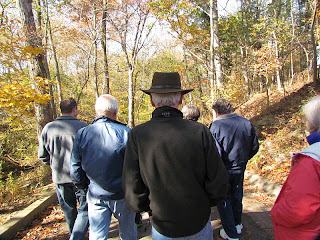Beneath the sandstone and shale ridges of Mammoth Cave National Park lies the most extensive cave system on earth. With over 365 miles of surveyed passage ways, Mammoth Cave is over twice as large as any other known cave. There are eleven different tours of the cave available ranging from one and one-quarter hours to six and one-half hours. They range in difficulty from "Easy" to "Very Strenuous." We chose to take the Mammoth Passage Tour -- one of the "easy" ones!
The trail down to the natural entrance to the cave is quite steep (and seemed even steeper when we climbed back up at the end of the tour!). Here is part of our group of fifteen or so heading down --
The transition from the outside to the dark and the rather low ceiling --
These are cribs where slaves piled cave dirt and guano in the cave to manufacture salt petre (to make black gun powder) during the war of 1812.
Beyond that is an area called the "Rotunda."--
The further we descended into the cavern the darker it got. I was very glad for the handrails put in many years ago by CCC workers, who made the trails.
The group standing in an area of the cave that clearly shows the layers carved out millions? of years ago by water and carbonic acid --
Here is our Park Ranger explaining that this portion of the cave is a "dry" cave with no active water, therefore no stalactites or stalagmite's. Many parts of the cave are still wet and are being still being carved out --
Mammoth Cave has been a tourist attraction since 1816 when tour guides were African-American slaves. It was authorized as a national park in 1926 and fully established in 1941. At that time, only forty miles of passageways had been mapped. The Ranger estimated that there were still more than three hundred miles of passages that have not yet been mapped.
All I know is that I was sure glad to see the light of the entrance as we came back out!
On our way back to Auntie Violet we saw a road sign pointing to "Civil War Battlefield." Since we are in the south, we thought we should at least check one out, so we followed it. It took us to a farmstead which is now the "Battle for the Bridge" battlefield site Historic Preserve. I did not realize that Kentucky had NOT seceded from the Union and joined the Confederacy. They chose to be a slave state, but to remain neutral (both the Union and the Confederacy established capitals in the state...).
The Kentucky railroads proved to be too important to both sides and many battles were fought over control of them. This battle was over control of the railroad bridge that can be seen in the distance from the farmhouse --
The land between the farmstead and the bridge is now in private hands, so you cannot walk over that portion of the battlefield. The Rowland family submitted claims of $12,000 to the government for the damages to their farmland and buildings, but because Rowland was falsely claimed to be a "southern man," they were denied. Eventually, they received a little over $4000 to rebuild their house.










Very interesting. I went to Mammoth cave in 1961 but I never knew it was near a civil war battle site until today. Thank you for the tour.!!
ReplyDelete